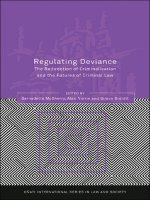Consumer Protection and the Criminal Law Law, Theory, and Policy in the UK potx
Bạn đang xem bản rút gọn của tài liệu. Xem và tải ngay bản đầy đủ của tài liệu tại đây (981.13 KB, 269 trang )
This page intentionally left blank
Consumer Protection and the Criminal Law
Law, Theory, and Policy in the UK
To what extent should criminal law be used to protect the consumer? In
this important new study Peter Cartwright evaluates the role of criminal
law sanctions in consumer protection from an economic and social per-
spective. The author examines the rationales for protecting consumers,
and considers the role that legal techniques play in fulfilling these. He
then evaluates the interests that consumer law protects, such as physical
integrity and economic interests. In addition, he analyses the nature of
criminal law doctrines such as strict, corporate, and vicarious liability,
and suggests that such doctrines require re-evaluation in the light of the
reality of the corporate entity.
This study will be of interest to academics, undergraduate and post-
graduate students, and practitioners.
PETER CARTWRIGHT is a senior lecturer in the School of Law at
the University of Nottingham. He specialises in consumer protection,
criminal law, and banking regulation. His publications include Consumer
Protection in Financial Services (1999), as well as many articles.
Consumer Protection and
the Criminal Law
Law, Theory, and Policy in the UK
Peter Cartwright
The Pitt Building, Trumpington Street, Cambridge, United Kingdom
The Edinburgh Building, Cambridge CB2 2RU, UK
40 West 20th Street, New York, NY 10011-4211, USA
477 Williamstown Road, Port Melbourne, VIC 3207, Australia
Ruiz de Alarcón 13, 28014 Madrid, Spain
Dock House, The Waterfront, Cape Town 8001, South Africa
First published in printed format
ISBN 0-521-59080-9 hardback
ISBN 0-511-03897-6 eBook
Cambrid
g
e University Press 2004
2001
(Adobe Reader)
©
To Sue, Emma, and Joe
Contents
Prefacepageix
Acknowledgementsxii
Listofabbreviationsxiii
1Consumerprotectionrationales1
2Techniquesofregulation40
3Theroleofcriminalsanctionsinconsumerprotection63
4Theuseofthecriminallaw87
5Consumersandsafety:theprotectionofphysicalintegrity126
6Theprotectionofeconomicinterests156
7Theenforcementofregulatoryconsumerlaw212
8Conclusions244
Index250
vii
Preface
Consumer protection law and criminal law hav
e both received consider-
able analysis from academic lawyers. The role of legal intervention with
the aim of protecting the consumer has come in for scrutin
y in a number
of seminal works, many of which concentrate upon the role of consumer
law in the marketplace. The role of criminal law has also been discussed
by a large number of leading commentators, with particular attention be-
ing paid to the boundaries of criminal sanctions, and particular concern
being addressed to increasing criminalisation. Against this background, it
is surprising that so little has been written about the role of criminal sanc-
tions in the protection of the consumer. The criminal law has been
the
prime technique used by successive post-war governments to implement
consumer policy in the UK. Intervention in the civil law to protect the
consumer has been less frequent, although a number of impor
tant exam-
ples of this exist. Strict liability regulatory offences, tempered by statutory
defences, remain the paradigm of UK consumer protection law.
This book aims to be the first major monograph to examine the role of
criminal sanctions in the protection of the consumer. Although focusing
on the UK, much of the analysis in this work is relevant wherever matters
of consumer policy
are being considered. The book provides a critique of
regulatory consumer law, by examining the objectives of consumer pol-
icy, the role of criminal law in society, and the extent to which consumer
protection is an appropriate topic with which criminal law can deal. The
book seeks to achieve its aims in the following ways. First, it investigates
the justification for having consumer protection laws, and considers the
regulatory techniques available to fulfil consumer policy objectives. Al-
though much of the traditional analysis of consumer protection law has
focused on its economic role in correcting market failure, it will be argued
that the social objectives of consumer law should be given greater atten-
tion. Secondly, the book examines the role, and the use, of criminal law
in society, with particular reference to the concept of the regulatory of-
fence. There has been considerable concern from liberal criminal justice
scholars at what is perceived as over-criminalisation in general, and it is
ix
x Preface
largely in the regulatory field that the increase in criminalisation has been
witnessed. It will be argued that while there is merit in these concerns,
criminal law should retain its central function in the protection of the
consumer. Rather than a policy of decriminalisation, what is needed is a
reassessment of the ways in which regulatory crime operates, with par-
ticular attention being focused on the categories of defendant to whom
the law applies, and the techniques by which they are held responsible.
The book next examines the law on the basis of the interests that it aims
to protect. The two principal interests of concern here are physical safety
and economic interests. Where physical safety is at issue, the prime aim of
the law is relatively clear. It is concerned to ensure that consumers are not
harmed by unreasonably dangerous products. But this simple assertion
obscures a plethora of more complex matters. Product safety regulations
are a way in which invidious barriers to trade may be erected under the
guise of consumer protection. The legislation which contains the major-
ity of the UK’s consumer product safety law is based upon a European
Directive aimed primarily at facilitating the free movement of goods. It is
vital that the role of the criminal law in product safety is assessed against
this economic background. Product safety law also provides a useful illus-
tration of the social justification for intervention to protect the consumer.
Although it is possible to explain much consumer product safety law on
economic grounds of market failure, such as information deficits and
externalities, it is also important to consider the extent to which social
goals justify intervention. Where consumers’ economic interests are be-
ing considered more difficulties arise, in particular because the objectives
of intervention are less obvious. Should intervention address information
deficits that might lead consumers to make inappropriate decisions, or
try to ensure that transactions are fair? If the latter, are we concerned with
substantive or merely procedural fairness? The law of contract has had
to grapple with these issues for some time, but they also have implica-
tions for criminal law. For example, quality regulation has generally been
viewed as the domain of the law of contract, but the criminal law may also
have a role to play here, such as in ensuring that consumers receive goods
of acceptable quality. It is perhaps in the area of economic interests that
administrative sanctions could have an increasingly important role, and
the role of such sanctions in fair trading law is considered in this context.
Consumer law will only achieve its objectives if it is enforced effectively.
Considerable empirical research has been undertaken on the strategies
adopted by enforcement agencies, most of it concluding that enforcement
authorities such as trading standards officers favour compliance to deter-
rence strategies. Although there have been criticisms of this approach,
there appear to be benefits to a strategy which emphasises the primacy
Preface xi
of securing compliance, provided prosecution is utilised where informal
enforcement fails. The ‘tit for tat’ strategy favoured by Ayres and Braith-
waite bears many similarities to the approach found in the UK and chap-
ter 7 argues that it may be the most appropriate strategy for enforcement
authorities to adopt.
The book’s discussion of the role of criminal sanctions in consumer
protection will reveal the wide variety of roles that criminal law plays
in society, from stigmatising immoral conduct to improving trading stan-
dards. Criminal sanctions play an important part in protecting consumers
by discouraging unacceptable conduct and providing a sanction where
that discouragement fails. Many of the objections to the use of criminal
law in consumer protection appear premised upon a view of the criminal
law as something which should deal only with wicked conduct. However,
it will be argued that the regulation of anti-social, harmful, and undesir-
able conduct is equally the criminal law’s business. This is not to suggest
that the law is not in need of reform. It will be argued throughout this
book that we need to address several important issues, such as the use
(and abuse) of corporate and vicarious liability, the relationship between
criminal law and other legal forms, and the role of enforcement author-
ities. It is only in so doing that we will be able to construct a regulatory
consumer law which is fit for the twenty-first century.
Acknowledgements
I have incurred many debts in writing this
book. First, I would like
to thank Geraint Howells, Paul Roberts, and Steve Weatherill, all of
whom commented on drafts of chapters in this book. It has certainly
been improved by their input. The Learned Societies Fund of the Uni-
versity of Wales, Aberystwyth, and the Academic Purposes Fund of the
Society of Public Teachers of Law, enabled me to secure the excellent ser-
vices of my research assistant Yvonne Williams. Moral support was pro-
vided by many, particularly former colleagues Andy Campbell and Gavin
Dingwall. As always, I would like to thank my family for their love and
support. My wife Sue was a constant source of help and encouragement,
and our daughter Emma helped to put it all in perspective. Finally, I would
like to thank our son, Joe, whose arrival in the world on 18 October 2000
provided a partial excuse for the late submission of the manuscript.
PETER CARTWRIGHT
Edwalton
31 October 2000
xii
Abbreviations
AC Appeal cases
Adm LJ Administrative Law Journal
All ER All England Law Reports
B&S Best and Smith Reports
BTLC Butterworths Trading Law Cases
Br J Criminology British Journal of Criminology
Cal LR California Law Review
CLJ Cambridge Law Journal
CLP Current Legal Problems
CMLR Common Market Law Review
Consum LJ Consumer Law Journal
Cr App R Criminal Appeal Reports
Crim LR Criminal Law Review
DLR Dominion Law Reports
Econ J Economic Journal
EHRR European Human Rights Reports
F2d Federal Reporter
FTC Federal Trade Commission
Harvard LR Harvard Law Review
HL Debs House of Lords Debates
ICR Industrial Cases Reports
ITSA MR Institute of Trading Standards Administration Monthly
Review
JBL Journal of Business Law
JCLC Journal of Criminal Law and Criminology
JCMS Journal of Common Market Studies
JCP Journal of Consumer Policy
J Legal Stud Journal of Legal Studies
JP Justice of the Peace
J Pol Econ Journal of Political Economy
KB King’s Bench
Law and Pol Q Law and Policy Quarterly
xiii
xiv Abbreviations
LGR Local Government Reports
LMCLQ Lloyds Maritime and Commercial Law Quarterly
LQR Law Quarterly Review
LR Law Reports
LSG Law Society Gazette
Mich LR Michigan Law Review
MLR Modern Law Review
M&W Meeson & Welsby Reports
NILQ Northern Ireland Legal Quarterly
NLJ New Law Journal
OJ Official Journal
OJLS Oxford Journal of Legal Studies
QBD Queen’s Bench Division
QJEcon Quarterly Journal of Economics
RTR Road Traffic Reports
SI Statutory Instrument
Sol J Solicitors’ Journal
Stra Strange’s King’s Bench Reports
Sup Ct Rev Supreme Court Review
Tr LR Trading Law Reports
Tulane LR Tulane Law Review
U Chicago LR University of Chicago Law Review
U Penn LR University of Pennsylvania Law Reports
Wash ULQ Washington University Law Quarterly
Wash ULR Washington University Law Review
Wisc LR Wisconsin Law Review
WLR Weekly Law Reports
Web JCLI Journal of Current Legal Issues
Yale LJ Yale Law Journal
1 Consumer protection rationales
Introduction
Laws have been used to protect consumers for centuries. These laws
have drawn on a variety of legal forms, including criminal law, tort,
and contract, to achieve their objectives. In addition to those laws that
specify consumer protection as their primary concern, numerous other
provisions have the effect of protecting the consumer, for example by
streamlining the prosecution of fraud, protecting property, or facilitating
litigation.
1
As a result, the boundaries of consumer protection
law are not
easily drawn. This book is concerned primarily with those laws that have
consumer protection as their main objective, and which use the criminal
law to achieve this objective.
2
This chapter examines the role of law in consumer protection, focusing
upon the objectives of consumer protection. In order to achieve this, we
need to consider a number of matters. First, we need to identify ‘the con-
sumer’ whom we are concerned to protect. Secondly, we need to consider
the relationship between consumer protection and the market economy.
It is sometimes argued that the state, through the law, should play only a
restricted role in protecting consumers, because consumer protection is
most effectively achieved by the operation of free and open markets. Law
should be used to ensure that the markets function as freely as possible.
Where markets do not work perfectly, the law should intervene to ad-
dress this failure, provided this can be done cost effectively. Thirdly, this
chapter will consider the extent to which consumer protection should
concern itself with social, non-market-based goals. While accepting the
importance of market and social goals, it is argued that the distinction
between the two is not clearly drawn, and that some approaches could be
viewed under either heading. Using the language of efficiency and equity
1
See for example, the Misrepresentation Act 1967, the Theft Act 1968, and the Civil
Procedure Rules 1998 (as amended).
2
It is recognised that many of these statutes will have additional aims, in particular, the
protection of honest traders and the encouraging of fair competition.
1
2 Consumer protection and the criminal law
rather than market and social goals, Ramsay observes that ‘[a]n efficient
policy is ultimately justified by equity since consumers are able to obtain
goods and services of a quality, on terms, and at the price that they are
willing to pay’.
3
Although helpful for the purposes of structure, the mar-
ket/social distinction is imperfect in practice. The chapter concludes that
the market, underpinned by private law, is an important technique for
ensuring that consumers are able to purchase the goods and services that
they want, and that intervention which helps the market to function is
valuable. However, social goals are being recognised as increasingly im-
portant and it is important for any effective consumer protection policy
to address both.
Who is a consumer?
Describing something as a consumer protection statute implies that there
is someone who can be identified clearly as a ‘consumer’. Although the
private buyer of goods is perhaps our paradigmatic consumer, she has
been joined by a wealth of other economic actors who can lay claim to
forming part of that diverse group. As a result, there is the initial difficulty
of identifying our subject matter. The first point to note is that there is no
universally agreed definition of the term ‘consumer’, although a number
of statutes, both criminal and civil, attempt to define it for their own
purposes. One example of such a definition is found in s.20(6) of the
Consumer Protection Act 1987, which states:
‘consumer’
(a) in relation to any goods, means any person who might wish to be
supplied with the goods for his own private use or consumption;
(b) in relation to any services or facilities, means any person who might
wish to be provided with the services or facilities otherwise than for
the purposes of any business of his; and
(c) in relation to any accommodation, means any person who might wish
to occupy the accommodation otherwise than for the purposes of any
business of his.
Another example is contained in s.12 of the Unfair Contract Terms
Act 1977. This states that a party to a contract deals as a consumer if
‘(a) he neither makes the contract in the course of a business nor holds
himself out as doing so; and (b) the other party does make the contract in
3
Iain Ramsay, Rationales for Intervention in the Consumer Marketplace (London, Office of
Fair Trading, 1984), p. 12.
Consumer protection rationales 3
the course of a business’. Regulation 2 of the Unfair Terms in Consumer
Contracts Regulations 1999 provides a further approach, describing a
consumer as ‘a natural person who, in making a contract to which these
Regulations apply, is acting for purposes which are outside his business’.
These definitions suggest that the consumer is a private individual acting
in a private capacity. A further paradigm of consumer protection statutes
is that the defendant must act in the course of a trade or business.
4
How-
ever, some UK statutes which would undoubtedly be regarded as exam-
ples of ‘consumer protection’ legislation fall outside this description. For
example, the Trade Descriptions Act 1968 prohibits the supply of false
and misleading information in business to business transactions.
5
There
is also a suggestion that the Act might prohibit misdescriptions applied
by private individuals, albeit in limited circumstances.
6
It seems that the main characteristics of consumer protection statutes
are that the supplier acts in the course of a trade or business, the
re-
cipient is a private individual, and the recipient acts in a private capac-
ity. It should be remembered that it is important not to limit the term
‘consumer’ to contracting parties, as that might exclude the ultimate
user of goods and services, such as the plaintiff in Donoghue v. Stevenson
whom Jolowicz describes as ‘the law’s best known consumer’.
7
Indeed,
it is possible to develop a much wider concept of the consumer
than
has traditionally been envisaged.
8
A private individual who receives ser-
vices from a non-commercial state author
ity, such as the user of National
Health Service facilities or even the recipient of state benefit, might be
aptly described as a consumer. As Kennedy has stated, ‘consumerism is
just as concerned with the supply of services as with goods. The con-
sumer merely becomes the client, or patient, or whatever rather than
the shopper.’
9
We could even go as far as Ralph Nader, the American
consumer rights activist, and equate the word ‘consumer’ with ‘citi-
zen’. Scott and Black point out that the consumer interest is involved
whenever citizens enter relationships with bodies such as hospitals and
4
For discussion of the meaning of this see Richard J. Bragg, Trade Descriptions (Oxford,
Clarendon Press, 1991), ch. 2.
5
See Shropshire County Council v. Simon Dudley Ltd (1997) 16 Trading Law 69.
6
See Olgeirsson v. Kitching [1986] 1 WLR 304, although it is submitted that this case is
wrongly decided.
7
J. A. Jolowicz, ‘The Protection of the Consumer and Purchaser of Goods Under English
Law’ (1969) 32 MLR 1, 1.
8
For discussion see I. Ramsay, Consumer Protection: Text and Materials (London, Weiden-
feld and Nicolson, 1989), ch. 1 and C. Scott and J. Black, Cranston’s Consumers and the
Law (3rd edn London, Butterworths, 2000), pp. 8–11.
9
I. Kennedy, The Unmasking of Medicine (The 1980 Reith Lectures) (London, Allen and
Unwin, 1981), p. 117. Cited in Ramsay, Consumer Protection, pp. 11–12.
4 Consumer protection and the criminal law
libraries.
10
The Molony Committee, which was set up in 1959 to con-
sider and report on changes to consumer law, opined that the consumer is
‘everybody all of the time’. However, the committee did not suggest this
as a working definition of the term, limiting their ambit to the purchase of
or obtaining on hire purchase goods for private use and consumption.
11
This illustrates the numerous contexts in which an individual could be
regarded as a consumer. It is interesting to note that when the idea of
the Citizen’s Charter was taking shape, there was some discussion about
whether it should be referred to as the ‘Consumer’s Charter’. The former
title was agreed upon, as the term ‘consumer’ was seen as ‘narrow [and]
econocratic’.
12
Equating ‘consumer’ with ‘citizen’ has the benefit
of en-
abling us to look beyond the narrow economic function of the consumer,
and to consider the individual’s wider role in society. This is important
in areas such as financial services where a strict economic definition of
consumer might exclude private investors.
13
It thus becomes easier to see
rights against the state as consumer issues. However, there is the danger
that the term ‘consumer’ could become almost meaningless. Indeed, it
could be argued that the legacy of the Citizen’s Charter is that citizens
have increasing been treated as consumers, rather than consumer
sas
citizens.
14
This book does not propose to offer a prescriptive definition of the
consumer. It is concerned to examine the way in which criminal law is
used in the context of consumer protection in the UK, but the UK has
no agreed definition of the consumer. Few could deny that the Trade
Descriptions Act 1968 and the Consumer Protection Act 1987 are prop-
erly described as consumer protection statutes, even though they take
different approaches to whom they protect. It is therefore suggested that
we should eschew a narrow definitional approach to the concept of the
consumer, recognising that statutes may legitimately take different ap-
proaches to this issue. Nevertheless, we should recognise that this book
is primarily concerned with those statutes which aim to protect the buy-
ers of goods and services from the misbehaviour of traders and which use
the criminal law to do so.
10
See Scott and Black, Cranston’s Consumers and the Law, pp. 8–11.
11
Board of Trade Final Report of the Committee on Consumer Protection (the Molony
Committee) Cmnd 1781/1962, para. 16.
12
S. Hogg and J. Hill, Too Close to Call: Power and Politics – John Major in No. 10 (London,
Warner, 1995), p. 94.
13
See P. Cartwright, ‘Consumer Protection in Financial Services: Putting the Law in
Context’ in P. Cartwright (ed.), Consumer Protection in Financial Services (Deventer,
Kluwer, 1999) and C. J. Miller, B. W. Harvey, and D. L. Parry, Consumer and Trading
Law: Text Cases and Materials (Oxford, Oxford University Press, 1998), pp. 5–6.
14
A. Barron and C. Scott, ‘The Citizen’s Charter Programme’ (1992) 55 MLR 526.
Consumer protection rationales 5
Consumer protection and the market system
The perfect market
When examining why we intervene in the market to protect consumers,
it is possible to take the so-called ‘perfect market’ as a starting point.
This is helpful even if we doubt that such a system is attainable in real-
ity. Free market economic theory suggests that if the characteristics of a
perfect market could be created, there would be no need for regulation.
In one of the leading studies, Rationales for Intervention in the Consumer
Market Place, Ramsay identifies the characteristics of the perfect market
as follows:
(i) there are numerous buyers and sellers in the market, such that the
activities of any one economic actor will have only a minimal impact
on the output or price of the market;
(ii) there is free entry into and exit from the market;
(iii) the commodity sold in the market is homogeneous; that is, essentially
the same product is
sold by each seller in the particular market;
(iv) all economic actors in the market have perfect information about the
nature and value of the commodities traded;
(v) all the costs of producing the commodity are borne by the producer
and all the benefits of a commodity accrue to the consumer – that
is, there are no externalities.
15
Those who champion the idea of the perfect market see markets as
efficient and effective tools for maximising consumer welfare. The ex-
pressions ‘free market economics’ and ‘free market economists’ are used
in this context for want of a better term. It is recognised that this is not
a perfectly homogeneous group. This approach, which is associated pri-
marily with the Chicago School, makes assumptions about the ways in
which markets operate.
16
First, it assumes that individuals are rational
maximisers of their own satisfaction. In other words, they know what
they want, and will make logical, consistent choices in accordance with
their wishes. Secondly, it assumes that by their choices, consumers in-
fluence producers and so dictate the way that the market operates. By
making choices in accordance with their wishes, consumers send signals
to traders. If traders do not respond to these wishes they will lose custom
and, ultimately, be forced to exit the market. The consumer is therefore
sovereign.
15
Ramsay, Rationales, pp. 15–16.
16
For a useful discussion see Scott and Black, Cranston’s Consumers and the Law, pp. 26–9.
6 Consumer protection and the criminal law
The market system can be viewed as desirable for two main reasons.
First, it is economically desirable because it is efficient. Traders com-
pete with each other to win custom, thereby raising standards and lower-
ing prices. Secondly, it is seen as ideologically desirable that individuals’
choices should be respected, rather than a choice made on their behalf
by the state. Indeed, many supporters of the free market seem as much
influenced by ideological matters as by efficiency arguments.
17
The free
market recognises that different consumers are likely to be prepared to
endure different levels of product safety and quality for different amounts
of money. Where this is the case, a variety of products will be supplied
with different levels of quality and safety for different prices. It is for
consumers to act rationally in accordance with their own preferences
and decide upon the level of safety or quality that they are prepared to
purchase.
The perfect market only exists where the requirements set out in Ram-
say’s list are met, although we may still have competitive markets where
not all are present. If we have numerous buyers and sellers competing
with each other, no individual trader should be able to influence price
appreciably by varying output.
18
By ensuring that there is free entry into
and exit from the market, we ensure that anyone who wishes to enter a
particular market may do so, and that anyone who
does not respond to
consumer demand will be forced to exit the market. By having perfect
information, we ensure that the choices that consumers make are fully
informed, and so likely to give effect to their true wishes. Where external-
ities do not occur we can be sure that only the parties to a transaction are
affected by that transaction, and so the price of the transaction reflects
its value to the parties. Free market economics tells us that where these
factors are present there is no need for the state to intervene. However,
that does not mean that the state has no role in the free market, as we
will now see.
The market, the state, and the law
Although free market economics is frequently associated with rolling back
the frontiers of the state, this does not mean that the free
market requires
the state to lose its role in all areas.
19
On the contrary, for the market
17
SeeC.Fried,Contract as Promise: A Theory of Contractual Obligation (Cambridge, Mass.,
Harvard University Press, 1981) and P. S. Atiyah, ‘The Liberal Theory of Contract’ in
P. S. Atiyah, Essays on Contract (Oxford, Clarendon Press, 1990), p. 121.
18
F. M. Scherer, Industrial Market Structure and Economic Performance (2nd edn, Boston,
1980), p. 10.
19
Andrew Gamble, The Free Economy and the Strong State: The Politics of Thatcherism (2nd
edn, Basingstoke, Macmillan, 1994), ch. 2.
Consumer protection rationales 7
to function effectively it is vital that the state retains its strength. Frank
Knight observed that ‘the [market] system as a whole is dependent upon
an outside organisation, an authoritarian state to provide a setting in
which it can operate at all’.
20
The state should, therefore, not be seen
as an alternative to the market, but as an essential part of the market
system. Hutchinson similarly comments that ‘[w]ithout a state willing
or able to define and protect property rights, enforce contracts and pre-
vent involuntary transactions, maintain a circulating medium, and curtail
monopoly and anti-competitive behaviour, there is no market in any real
or meaningful sense’.
21
The state is therefore vital to set up and enforce
the structure in which the market operates. This is done through
the
mechanism of law. Law determines the ‘rules of the game’ in the first
place, and acts as an
umpire to interpret and enforce those rules.
22
For
example, competition/anti-trust law ensures that markets are open and
that competition exists. Property law sets out the rules of property and so
determines rights of o
wnership, and explains how title can pass. Crimi-
nal law ensures that such rights are protected. As the market is premised
upon the importance of exchange, the rules of contract law have to be
set
out. There is no inherent conflict between a strong state, strong
laws,
and the free market.
Although the state has to be strong for the market system to function
effectively, the state only imposes its views on citizens in order to ensure
that parties are held to their agreements. It is individuals’ choices that
count, rather than those of the state. As a consequence, laws prohibiting
fraud and force are seen as protecting the private rights of citizens rather
than enforcing the state’s aims on those citizens.
23
The prime method by
which choices can be demonstrated and effected is through the private
law of contract. The next section considers the use of the private law to
protect consumers within the context of the market. It focuses on the
role and limitations of the law of contract, but also considers the place of
the law of tort. Although contract law could be viewed as a technique of
regulation, and so might be thought of as more appropriately placed in our
discussion of techniques of regulation, its almost symbiotic relationship
with the market has led it to be considered here.
24
20
F. Knight, ‘Some Fallacies in the Interpretation of Social Cost’ (1924) 38 QJEcon 582
at 606.
21
A. Hutchinson, ‘Life After Shopping: From Consumers to Citizens’ in I. Ramsay (ed.),
Consumer Law in the Global Economy (Aldershot, Dartmouth and Ashgale, 1997), p. 25
at p. 31.
22
See M. Friedman, Capitalism and Freedom (Chicago, Chicago University Press, 1962).
23
See J. Raz, ‘Promises in Morality and Law’ (1982) 95 Harvard LR 916.
24
For an excellent examination of contract law as a form of regulation see H. Collins,
Regulating Contracts (Oxford, Oxford University Press, 1999).
8 Consumer protection and the criminal law
The use and limitations of private law
The role of contract
The law of contract is central to the effective working of the market. Con-
tracts provide a mechanism through which individuals can express their
preferences, create agreements with others, and ensure that those agree-
ments are fulfilled. Contract law provides a framework through which
the market can function. The classical theory of freedom of contract has
been central to the development of contract law and its relationship with
the market. As Sir George Jessel famously argued: ‘[i]f there is one thing
which more than another public policy requires it is that men of full age
and competent understanding shall have the utmost liberty of contract-
ing, and that their contracts entered into freely and voluntarily shall be
held sacred and shall be enforced by courts of justice’.
25
Although cham-
pioned by the ‘New Right’ in the 1980s, classical theory was originally as-
sociated with left-wing movements in the nineteenth century, concerned
that the people should be allowed control over their destinies.
26
Classical theory’s emphasis on freedom of contract is a natural conse-
quence of putting faith in the market. Consumer sovereignty demands
the means by which the consumer can exercise choice. If we accept that
consumers are rational maximisers of their own satisfaction, then it is
logical that they should decide the transactions into which they wish
to enter, and the terms upon which those transactions will be entered.
Intervention by the state beyond that agreed by the parties is therefore
anathema to the traditional idea of contractual freedom. Classical theory
was characterised by free dealing and non-intervention in substantive
matters. It was concerned with fairness, but primarily in relation to pro-
cedure rather than substance, acting as an ‘umpire’ to be appealed to
when a foul is alleged.
27
However, it is a moot point whether the law
of contract ever championed the kind of freedom to which Sir George
Jessel alluded. Despite the significant extent to which classical theory has
been emphasised in writing, some commentators question how influen-
tial it was in practice. Reiter refers to Jessel’s view as ‘simply wrong’,
28
and Atiyah notes several ways in which contractual freedom was limited,
25
Printing and Numerical Registering Co.v.Sampson (1875) LR 19 Eq 462 at 465.
26
See P. S. Atiyah, ‘Freedom of Contract and the New Right’ in Atiyah, Essays on Contract,
p. 355 at p. 357.
27
P. S. Atiyah, The Rise and Fall of Freedom of Contract (Oxford, Clarendon Press, 1979),
p. 404. For an even stronger defence of individual autonomy see R. Nozick, Anarchy,
State and Utopia (Oxford, Blackwell, 1974).
28
B. Reiter, ‘The Control of Contract Power’ (1981) 1 OJLS 347.
Consumer protection rationales 9
even in the so-called heyday of classical theory.
29
Nevertheless, the phi-
losophy of classical theory was influential, and can be used to explain
many of the characteristics of twentieth-century contract law.
Classical theory’s aversion to intervention on the grounds of substan-
tive fairness can be justified on a number of different grounds. Collins
identifies four main propositions which underlie this, none of which con-
vinces him.
30
It is worth saying a few words about these, as they pro-
vide both an authoritative summary of the key characteristics of classical
theory and a useful critique of its principal arguments.
First, classical theory’s adherents argue that most instances of appar-
ent unfairness turn out to be illusory. For example, most terms which
appear to be unfair will be balanced by corresponding benefits, such as a
reduction in price. As a result, it is difficult to determine that a voluntary
exchange is unfair.
31
Collins accepts that we should not jump to conclu-
sions concerning the unfairness of transactions, and that unfair contracts
are more difficult to detect than might first
be thought. However, he
recognises that unfair contracts do exist, and that the important point is
to engage in a detailed examination of the particular circumstances of the
transaction, and to take the whole picture into account.
32
Secondly, it has been argued that approaches which allow contracts
to be challenged on the basis of fairness will make it more difficult
to construct markets, a prime aim of contract law. Several statutes al-
low contracts to be challenged on the basis of substantive unfairness,
although different terms are used in different contexts. For example,
the Unfair Terms in Consumer Contracts Regulations 1999 allow the
courts to strike down a term in a consumer contract which ‘contrary
to the requirement of good faith causes a significant imbalance in the
parties’ rights and obligations under the contract to the detriment of
the consumer’. Also s.137(1) of the Consumer Credit Act 1974 allows
a consumer to challenge a credit bargain on the grounds of its being ex-
tortionate. Although these provisions look appealing from the
point of
view of equity, there is an argument that they create uncertainty for the
contracting parties, which makes it difficult for those parties to predict
how their transactions will be judged. Collins questions this. First, he
argues that business people do not regard planning documents as cen-
tral to transactions and that as a result of this, uncertainty
about legal
29
Atiyah, The Rise and Fall of Freedom of Contract.
30
Collins, Regulating Contracts, ch. 11.
31
See M. J. Trebilcock, ‘The Doctrine of Inequality of Bargaining Power: Post Benthamite
Economics in the House of Lords’ (1976) 26 University of Toronto Law Journal 359.
32
Regulating Contracts, pp. 258–9.









